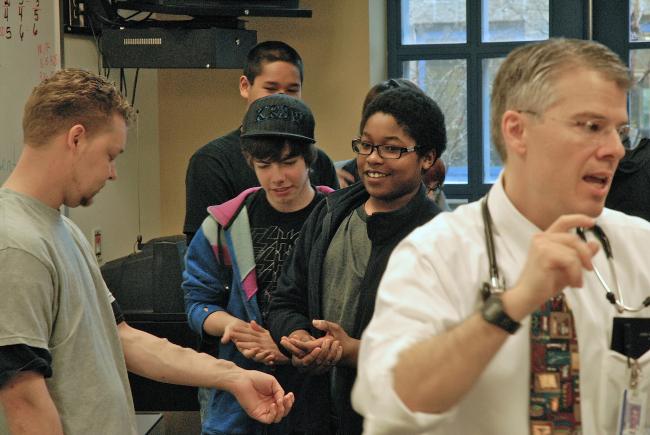WSHS students confront kidney disease realities
Left" Anthony Pritchard, 29, has kidney disease. He shows Linda Bothel's WSHS health class his "fistula," a medical procedure that connects artery with vein to allow easy access to a vein for dialysis as an alternative to a stint. UW nephrologist Dr. Eric Anderson, pictured right, advises students to cut down on sodium, avoid obesity, and not to smoke, to discourage kidney disease. Thursday, March 11, was World Kidney Day.
Thu, 03/11/2010
A frank, sometimes disturbing, demonstration about kidney disease was presented in Linda Bothel’s health class at West Seattle High School Thursday, March 11, to coincide with Word Kidney Day. Dr. Eric Anderson and colleague Dr. Kim Muczynski with the UW Department of Medicine Division of Kidney Diseases and Hypertension showed the class a small dialysis machine that separated urine from blood. Muczynski dissected a pig's kidney.
Cow blood circulated and filtered through an organized bundle of narrow thread-thin tubes stuffed inside a clear glass cylinder that allowed urine to exit the machine while the detoxed blood continued to flow.
Students’ interest escalated when Anthony Pritchard was introduced. They seemed to relate to the easy-going 29 year-old in jeans. He spoke of his ordeal with kidney disease.
“I lost sight in one eye when I was 18,” said Pritchard, from Auburn, who works full time on cars. “I had no appetite and lost weight. I went to a smaller hospital for a blood test. My blood pressure was 195/155.” Normal is 120/80.
“I was rushed to Children’s Hospital.”
The next day he started dialysis, four hours a day, three days a week. Dr. Anderson explained that Pritchard’s surgeons create a “fistula” or sewn-together artery and vein to allow nurses easy access when they insert a needle, an alternative to the catheter.
Pritchard received a kidney from his mother in 1999 that lasted five years, and then received a second from the cadaver of a 19 year-old female, he said. He carries a tackle box filled with blood pressure pills, vitamins and aspirin he must take twice a day, and he must be cautious around others who are sick because of his weakened immune system.
Although he is now off dialysis, his left arm still contains an enlarged, long, snake-like vein that appears to bulge out of his skin. The doctors asked willing students to touch it.
Anderson explained the harsh realities of eating heavily salted fast foods and said America is addicted to sodium. Too much sodium leads to high blood pressure, a gateway to kidney disease. The nephrologist visits the school once or twice each week to assist in health education to impress upon students the importance in preventing devastating diseases caused by uncontrolled high blood pressure.
He asked the students what the three major food groups are. One student answered wryly, “Junk food.”
In addition to poor diet, he said obesity and smoking are offenders that lead to high blood pressure.
“You’re thinking, ‘I’m young and this isn’t going to happen to me.’ Three-percent of kids your age have high blood pressure. One out of four will have high blood pressure as an adult. It is better to change your diet when you are young and healthy, not old and tired.
“Go back home and talk to your parents and friends who don’t care as much about what your kidneys do,” he added.
Pritchard told the class he recalled seeing infants and other young kids on dialysis machines at Children’s Hospital.
“When I graduated high school I had to go right into dialysis,” he said. “Before that I didn’t care what kidneys did.”
Anderson also spoke about Belding Scribner, a UW medicine professor who revolutionized long-term kidney dialysis and saved millions of lives. Scribner, head of the UW nephrology unit from 1958-1982, was an innovator of the dialysis machine and 50 years ago invented the “Scribner Shunt," a device that could be permanently installed in a patient's arm, making long-term kidney dialysis possible.
Before Scribner's innovations, kidney dialysis was a process that could be completed only five to seven times through a painful operation. Then, damage to arteries, veins and tissue would make future treatments impossible.
According to www.worldkidneyday.org, World Kidney Day is a joint initiative of the International Society of Nephrology (ISN) and the International Federation of Kidney Foundations (IFKF) to encourage systematic screening of all patients with diabetes and hypertension for Chronic Kidney Disease and also to encourage preventive behaviors.


